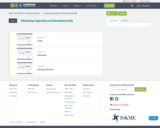
47 Results


Topics List for this Lesson: Points, Lines, Planes, and AnglesTriangles Plus Similarity and ProportionsPerimeter, Area, and CircumferenceVolume and Surface Area
- Subject:
- Mathematics
- Material Type:
- Full Course
- Author:
- Jillian Miller
- Megan Simmons
- Stefanie Holmes
- Jessica Chambers
- Brad Fox
- Heather Doncaster
- Ashley Morgan
- Misty Anderson
- Date Added:
- 07/08/2021
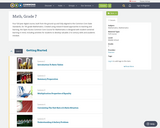
Four full-year digital course, built from the ground up and fully-aligned to the Common Core State Standards, for 7th grade Mathematics. Created using research-based approaches to teaching and learning, the Open Access Common Core Course for Mathematics is designed with student-centered learning in mind, including activities for students to develop valuable 21st century skills and academic mindset.
- Subject:
- Mathematics
- Material Type:
- Full Course
- Provider:
- Pearson
- Date Added:
- 10/06/2016

Algebraic Reasoning
Type of Unit: Concept
Prior Knowledge
Students should be able to:
Add, subtract, multiply, and divide rational numbers.
Evaluate expressions for a value of a variable.
Use the distributive property to generate equivalent expressions including combining like terms.
Understand solving an equation or inequality as a process of answering a question: which values from a specified set, if any, make the equation or inequality true?
Write and solve equations of the form x+p=q and px=q for cases in which p, q, and x are non-negative rational numbers.
Understand and graph solutions to inequalities x<c or x>c.
Use equations, tables, and graphs to represent the relationship between two variables.
Relate fractions, decimals, and percents.
Solve percent problems included those involving percent of increase or percent of decrease.
Lesson Flow
This unit covers all of the Common Core State Standards for Expressions and Equations in Grade 7. Students extend what they learned in Grade 6 about evaluating expressions and using properties to write equivalent expressions. They write, evaluate, and simplify expressions that now contain both positive and negative rational numbers. They write algebraic expressions for problem situations and discuss how different equivalent expressions can be used to represent different ways of solving the same problem. They make connections between various forms of rational numbers. Students apply what they learned in Grade 6 about solving equations such as x+2=6 or 3x=12 to solving equations such as 3x+6=12 and 3(x−2)=12. Students solve these equations using formal algebraic methods. The numbers in these equations can now be rational numbers. They use estimation and mental math to estimate solutions. They learn how solving linear inequalities differs from solving linear equations and then they solve and graph linear inequalities such as −3x+4<12. Students use inequalities to solve real-world problems, solving the problem first by arithmetic and then by writing and solving an inequality. They see that the solution of the algebraic inequality may differ from the solution to the problem.
- Subject:
- Algebra
- Mathematics
- Material Type:
- Unit of Study
- Provider:
- Pearson
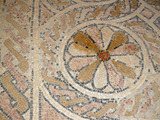
Students write expressions for geometric situations. They examine how different equivalent expressions can show different ways of thinking about the same problem.Key ConceptsStudents use their previous knowledge of how to find the perimeter and area of squares and rectangles. They write algebraic expressions for the perimeter and area of geometric figures. They examine how equivalent expressions, used to represent a problem situation, give clues to the approach the writer of the expression used to solve the problem. In the Challenge Problem, they use the distributive property to find the solution.ELL: For ELLs, access prior knowledge by writing the words area and perimeter on the board. Have students create concept maps associated with area and perimeter. Record students' responses on large poster paper that you can display in the room. The goal is to generate a list of words that students can use as a reference.Goals and Learning ObjectivesAccess prior knowledge of how to find the perimeter and area of squares and rectangles.Write algebraic expressions for finding perimeter or area of figures.Identify equivalent expressions.
- Subject:
- Geometry
- Material Type:
- Lesson Plan
- Date Added:
- 09/21/2015

(Nota: Esta es una traducción de un recurso educativo abierto creado por el Departamento de Educación del Estado de Nueva York (NYSED) como parte del proyecto "EngageNY" en 2013. Aunque el recurso real fue traducido por personas, la siguiente descripción se tradujo del inglés original usando Google Translate para ayudar a los usuarios potenciales a decidir si se adapta a sus necesidades y puede contener errores gramaticales o lingüísticos. La descripción original en inglés también se proporciona a continuación.)
Este módulo final del año de 40 días ofrece a los estudiantes una práctica intensiva con problemas de palabras, así como experiencias prácticas de investigación con geometría y perímetro. El módulo comienza con la resolución de problemas de palabras de uno y dos pasos basados en una variedad de temas estudiados durante todo el año, utilizando las cuatro operaciones. A continuación, los estudiantes exploran la geometría. Estudiantes Tessellate para la experiencia de la geometría de puente con el estudio del perímetro. Las parcelas de línea, familiares del Módulo 6, ayudan a los estudiantes a sacar conclusiones sobre las mediciones de perímetro y área. Los estudiantes resuelven problemas de palabras que involucran área y perímetro utilizando las cuatro operaciones. El módulo concluye con un conjunto de lecciones atractivas que revisan brevemente los conceptos fundamentales de grado 3 de fracciones, multiplicación y división.
Encuentre el resto de los recursos matemáticos de Engageny en https://archive.org/details/engageny-mathematics.
English Description:
This 40-day final module of the year offers students intensive practice with word problems, as well as hands-on investigation experiences with geometry and perimeter. The module begins with solving one- and two-step word problems based on a variety of topics studied throughout the year, using all four operations. Next students explore geometry. Students tessellate to bridge geometry experience with the study of perimeter. Line plots, familiar from Module 6, help students draw conclusions about perimeter and area measurements. Students solve word problems involving area and perimeter using all four operations. The module concludes with a set of engaging lessons that briefly review the fundamental Grade 3 concepts of fractions, multiplication, and division.
Find the rest of the EngageNY Mathematics resources at https://archive.org/details/engageny-mathematics.
- Subject:
- Geometry
- Mathematics
- Material Type:
- Module
- Provider:
- New York State Education Department
- Provider Set:
- EngageNY
- Date Added:
- 02/01/2014
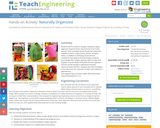
Students work in teams to design a tabletop supply organizer inspired by the natural home of an insect species. Their prototype stores the group’s classroom supplies (scissors, crayon boxes, pencils, and glue sticks). In addition to following measurement constraints that apply to their prototype, students must design their supply organizer with the idea that supplies must be easily retrievable and the organizer must be sturdy enough to withstand everyday classroom wear and tear. Students test their prototype in the classroom for a period of 5 days and evaluate its effectiveness.
- Subject:
- Applied Science
- Engineering
- Life Science
- Mathematics
- Measurement and Data
- Material Type:
- Activity/Lab
- Provider:
- TeachEngineering
- Provider Set:
- Activities
- Author:
- Meagan Vaughn
- Date Added:
- 07/01/2019
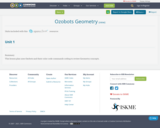
This lesson plan uses Ozobots and their color code commands coding to review Geometry concepts.
- Subject:
- Applied Science
- Computer Science
- Geometry
- Mathematics
- Material Type:
- Activity/Lab
- Date Added:
- 05/12/2021
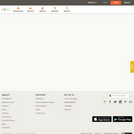
This short video and interactive assessment activity is designed to teach third graders about perimeter in grid.
- Subject:
- Mathematics
- Measurement and Data
- Material Type:
- Assessment
- Interactive
- Lecture
- Provider:
- CK-12 Foundation
- Provider Set:
- CK-12 Elementary Math
- Date Added:
- 03/04/2015
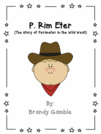
P. Rim Eter is a cowboy that is learning how to measure perimeter in the Wild West. This is a book for teachers and students to learn about the concept of perimeter. At the end of the book there are 3 activites for students to show mastery of the content.
- Subject:
- Mathematics
- Material Type:
- Activity/Lab
- Reading
- Author:
- Brandy Gamble
- Date Added:
- 06/23/2023
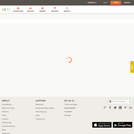
This short video and interactive assessment activity is designed to teach third graders about perimeter of squares and rectangles.
- Subject:
- Mathematics
- Measurement and Data
- Material Type:
- Assessment
- Interactive
- Lecture
- Provider:
- CK-12 Foundation
- Provider Set:
- CK-12 Elementary Math
- Date Added:
- 03/04/2015
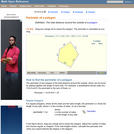
A web page and interactive applet show how to compute the perimeter of a polygon. A polygon is shown that can be resized by dragging its vertices. As you drag, the perimeter is continuously recalculated. Text on the page explains that the perimeter is the sum of the sides. For those who prefer it, in a formula that is given. Applet can be enlarged to full screen size for use with a classroom projector. This resource is a component of the Math Open Reference interactive geometry reference book project at http://www.mathopenref.com.
- Subject:
- Geometry
- Mathematics
- Material Type:
- Reading
- Simulation
- Provider:
- Math Open Reference
- Author:
- John Page
- Date Added:
- 02/16/2011
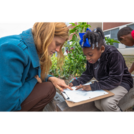
In this lesson the students will use their knowledge of measurement to determine perimeter and find missing lengths when given the total perimeter.
- Subject:
- Mathematics
- Material Type:
- Lesson Plan
- Author:
- Out Teach
- Date Added:
- 07/22/2021
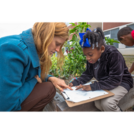
In this lesson the students will use their knowledge of measurement to determine perimeter. Since this is a virtual lesson for at home learning, steps will be included for students to make an 8 inch paper ruler out of notebook paper.
- Subject:
- Mathematics
- Material Type:
- Lesson Plan
- Author:
- Out Teach
- Date Added:
- 07/22/2021
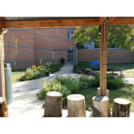
Students will use their knowledge of operations and estimation to solve real world problems.
- Subject:
- Mathematics
- Material Type:
- Lesson Plan
- Author:
- Out Teach
- Date Added:
- 07/22/2021
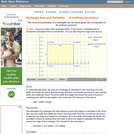
An interactive applet and associated web page showing how to find the area and perimeter of a rectangle from the coordinates of its vertices. The rectangle can be either parallel to the axes or rotated. The grid and coordinates can be turned on and off. The area and perimeter calculation can be turned off to permit class exercises and then turned back on the verify the answers. The applet can be printed as it appears on the screen to make handouts. The web page has a full description of the method for determining area and perimeter, a worked example and has links to other pages relating to coordinate geometry. Applet can be enlarged to full screen size for use with a classroom projector. This resource is a component of the Math Open Reference Interactive Geometry textbook project at http://www.mathopenref.com.
- Subject:
- Geometry
- Mathematics
- Material Type:
- Reading
- Simulation
- Provider:
- Math Open Reference
- Author:
- John Page
- Date Added:
- 02/16/2011
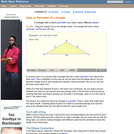
An interactive applet and associated web page that show the relationship between the perimeter and area of a triangle. It shows that a triangle with a constant perimeter does NOT have a constant area. The applet has a triangle with one vertex draggable and a constant perimeter. As you drag the vertex, it is clear that the area varies, even though the perimeter is constant. Optionally, you can see the path traced by the dragged vertex and see that it forms an ellipse. A link takes you to a page where this effect is exploited to construct an ellipse with string and pins. The applet can be enlarged to full screen size for use with a classroom projector. This resource is a component of the Math Open Reference Interactive Geometry textbook project at http://www.mathopenref.com.
- Subject:
- Geometry
- Mathematics
- Material Type:
- Reading
- Simulation
- Provider:
- Math Open Reference
- Author:
- John Page
- Date Added:
- 02/16/2011
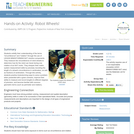
Students solidify their understanding of the terms "circumference" and "rotation" through the use of LEGO MINDSTORMS(TM) NXT robotics components. They measure the circumference of robot wheels to determine how far the robot can travel during one rotation of an NXT motor. They sharpen their metric system measurement skills by precisely recording the length of a wheel's circumference in centimeters, as well as fractions of centimeters. Through this activity, students practice brainstorming ways to solve a problem when presented with a given scenario, improve their ability to measure and record lengths to different degrees of precision, and become familiar with common geometric terms (such as perimeter and rotation).
- Subject:
- Applied Science
- Career and Technical Education
- Electronic Technology
- Engineering
- Material Type:
- Activity/Lab
- Provider:
- TeachEngineering
- Provider Set:
- TeachEngineering
- Author:
- Ursula Koniges
- Date Added:
- 09/18/2014

Students learn and practice how to find the perimeter of a polygonal shape. Using a ruler, they measure model rooms made of construction paper walls. They learn about other tools, such as a robot, that can help them take measurements. Using a robot built from a LEGO® MINDSTORMS® NXT kit that has been programmed to move along a wall and output the length of that wall, students record measurements and compare the perimeter value found with the robot to the perimeter found using a ruler. In both cases, students sketch maps to the scale of the model room and label the measured lengths. A concluding discussion explores the ways in which using a robot may be advantageous or disadvantageous, and real-world applications.
- Subject:
- Applied Science
- Engineering
- Geoscience
- Physical Science
- Physics
- Technology
- Material Type:
- Activity/Lab
- Provider:
- TeachEngineering
- Provider Set:
- TeachEngineering
- Author:
- Rezwana Uddin
- Date Added:
- 09/18/2014
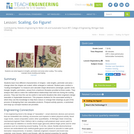
Students learn how different characteristics of shapes—side lengths, perimeter and area—change when the shapes are scaled, either enlarged or reduced. Student pairs conduct a “scaling investigation” to measure and calculate shape dimensions (rectangle, quarter circle, triangle; lengths, perimeters, areas) from a bedroom floorplan provided at three scales. They analyze their data to notice the mathematical relationships that hold true during the scaling process. They see how this can be useful in real-world situations like when engineers design wearable or implantable biosensors. This prepares students for the associated activity in which they use this knowledge to help them reduce or enlarge their drawings as part of the process of designing their own wearables products. Pre/post-activity quizzes, a worksheet and wrap-up concepts handout are provided.
- Subject:
- Career and Technical Education
- Mathematics
- Measurement and Data
- Numbers and Operations
- Material Type:
- Lesson
- Provider:
- TeachEngineering
- Author:
- Denise W. Carlson
- Evelynne Pyne
- Lauchlin Blue
- Date Added:
- 02/07/2017